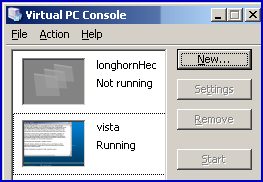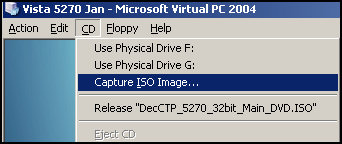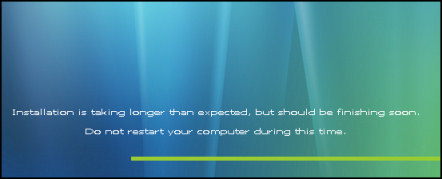Installing Windows Vista Beta 2 on Virtual PC 2004 (Build 5270)
When you decide to install Windows Vista Beta 2 on a Virtual Machine, don’t be in a hurry. Have a good book to read or a T.V. program to watch. The install takes hours and while there are long intervals where no human input is required, the whole procedure slows up the host machine.
Please note: here is an update featuring Windows Virtual PC 2007 SP1
Introduction to Installing Vista on Virtual PC 2004
From the outset I believed that it would be possible to install Vista Build 5270 on Microsoft’s Virtual PC 2004. My background is that I have installed about ten virtual machines before I installed Vista Beta 2. I choose to install Virtual PC 2004 on Windows Server 2003, even though the setup explicitly says this is not host operating system is not recommended. The reason that I mention these two facts is to give you confidence; to emphasise that while I am no great expert on Virtual PC, yet I got Vista working.
For experienced techies, who are geniuses at computing, all you need to do is absorb these key concepts:
- Download an Image from connect.microsoft, else get a CD.
- Create a new Virtual Machine with Virtual PC.
- Have a mixture of patience and faith that the Vista Beta 2 install will work.
For ordinary mortals, I will provide step-by-step instructions to help you install your Vista Beta 2 build 5270 on Virtual PC 2004. (Information on Build 5112)
Topics for Installing Vista Build 5270 on Virtual PC 2004
- First Goal – Get a Copy of the Build
- Second Goal – Create a Simple Virtual PC
- Third Goal – Capture the CD – Use Physical Drive
- Fourth Goal – Create a Partition for the Vista Install
- Post Installation Essential Tasks and Troubleshooting
First Goal – Get a Copy of the Vista Build
One of Microsoft’s satellite companies called Connect deals with Beta downloads. You can find them at connect.microsoft.com. The reason that I am vague about how I got started with Connect is purely bad memory. I cannot be sure whether it was a bonus of being an MCT, MVP or whether I just saw the site and applied to trial Microsoft’s Beta software.
What I do remember is getting stuck when I first joined, I could never seem to find the downloads, then I could not find the product keys – most frustrating. My message is once you have been accepted into the Vista Beta Program, search and you will find everything that you need there on the Connect site – somewhere. Incidentally, I also applied for the Exchange 12 Beta, and after a few days received links to downloads that DVD ISO image.
At this point, we need to download the Vista Beta 2 image. The Connect site supplied me with a file, which was a DVD image in ISO format. Incidentally, I applaud Microsoft on their download engine – File Transfer Manager, this software is intelligent and continues where you left off if the internet connection breaks.
Second Goal – Create a Simple Virtual PC
My advice is keep the New Virtual PC setup as simple as possible, just follow the defaults, the one exception is increase the 512 Ram memory for your Vista Virtual Machine. By all means adjust the settings once you have created the machine and installed the operating system.
- From the Virtual PC Console, click New…
- Create a virtual machine.
- Choose a location with at least 16 GB of free space.
- Operating System, Other or Windows Server 2003 doesn’t matter.
- Adjusting Ram – 512 MB Ram is recommended, I choose 1,000 MB.
- A new virtual hard disk.
- Name and Location. Previously, I created a special partition for VM images..
- Finish.
Third Goal – Capture the CD – Use Physical Drive…
The situation so far, we have downloaded the ISO DVD image, now we want to boot the Virtual Machine, not from the physical CD, but from the bootable ISO image.
What we do in the Virtual PC console, is click on the top menu called ‘CD’ and select – Capture ISO image, then browse to the location where you downloaded the ISO DVD. "DecCTP_5270_32bit_Main_DVD.ISO" in the screen shot.
.
Fourth Goal – Create a Partition and Install Vista
I was thrilled that the Virtual CD was able to boot from the image, the first few menus were straightforward. My problem was in creating a partition on the Virtual PC. The solution maybe as simple as resetting the Virtual Machine when you reach the menu opposite, ‘Where do you want to Install Windows?’. What I did was to click on New (Green Cross), created a new partition, selected Format (Red Bar) and only then Reset the Virtual Machine from the Action menu.
When the Virtual Machine restarted, it seemed as though I was repeating another failure, for example, Vista Beta 2 asked for the product key – again. Then a glimmer of hope, the partition information was just as I left it. Good news, this time, it asks for a machine name, I entered a NetBIOS name and the install carried on. The install then completed without anymore interaction from me. However, it does take for ever; including one long automatic reboot in the middle, thank goodness for the progress bar at the bottom of the screen, otherwise I would not have believed anything was happening.
One install menu both amazed and surprised me, is the above: ‘Installation is taking longer than expected, but should be finishing soon. Do not restart your computer during this time.’ I do believe that I was lucky in that I was doing other jobs and just left the install to progress at its own pace. If I had been watching, I would have been impatient and rebooted prematurely. It took over two hours to install on my Virtual Machine.
At the end of the install Vista asks you to set the Region and Time Zone. In terms of efficiency and intelligence, Vista has Microsoft’s best install to date. For example, XP installs are a pain in that the halt after about 10 minutes and ask you to input networking information. Vista had no such interruption, moreover it appeared to automatically detect the network and give it self, not an APIPA, but a suitable IP address for the subnet where I installed e.g. 192.168.0.10. This was not magic, it picked up the IP address either from and XP machine with Internet Sharing or the traditional DHCP server.
Post Installation Tasks and Troubleshooting
When the Vista Build 5270 finished installing I was desperately disappointed. The 256 color resolution meant an atrocious display of any graphics and the machine ran unacceptably slowly – even for Beta software. Then I remembered the Virtual Machine Additions. In a nutshell installing this add-on transformed my Vista 5270.
To install the Virtual Machine Additions I first selected Capture CD, this changed the menu from the ISO DVD, necessary for the install, to Use Physical Drive D: Next I selected the Action menu at the top Virtual PC 2004 console – Install Add Virtual Machine Additions. Wait for a Setup menu to appear, then click Ok and allow the Virtual Machine to restart.
On one occasion nothing happened, so I explored the captured D: and ran the InstallShield Wizard manually, I was relieved, and impressed to see it find new hardware, for example Graphics Adapter.
I found that the best setting for Network Adapter 1 was to select the host NIC. In particular, this configuration cured a specific problem: Virtual PC could not open the Virtual Machine Network Services driver, or The Virtual Machine Network Services driver has failed to install.
My machine was fortunate in having 2 GB of Ram, so I allocated 1 GB to Vista. The problem was the Virtual PC Console would not let me use more than 300 MB. The error was: The virtual machine could not be started because there was not enough memory available on the host.
The true problem was interference from other programs, in my case Nero CD burner, in another case SQL. So try judicious zapping images in Task manager until you find the root cause, I say again, take care ending processes. The safe way would be to remove programs via the Add or Remove Programs.
See Also
• Vista Home • How to Create Virtual Folders • Explorer Features




